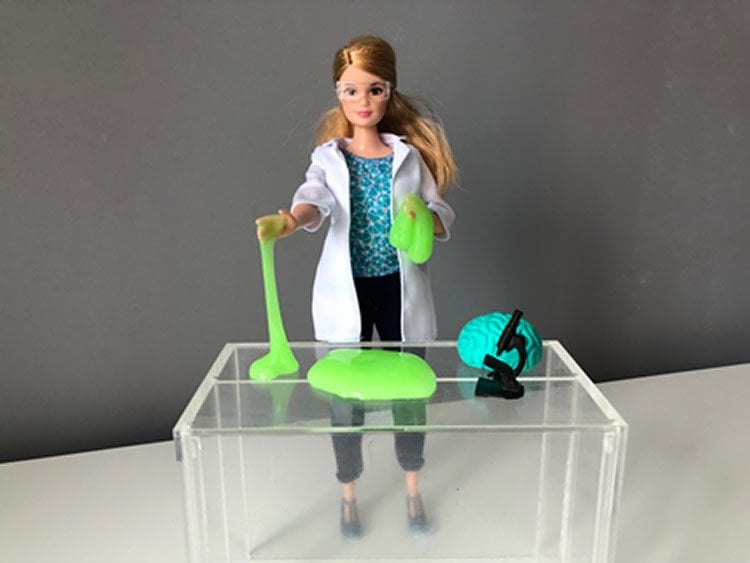Summary: With a new range of dolls focused on alternative body types and careers, Stacey Bedwell reports Barbie dolls may not have such a negative impact on a child’s development after all.
Source: Neuroscience News/Birmingham City University.
As a child born in the late 80s, I had my fair share of Barbie dolls. Barbie is still going strong, but is often in the media for negative reasons. There is a common fairly opinion that children playing with Barbie dolls gives them unwanted messages about body image and life aspirations. Lately I have been wondering just how true this idea really is. To give a little context, I class myself as a feminist, I refuse to buy my husband’s nephews gender stereo-typed toys, I fill with anger every time I hear a parent say boys can’t play with dolls or pink is for girls, and I play a big role in advocating STEM for girls. However, I do not have an issue with little girls (or boys) playing with Barbie dolls and similar toys – there are a lot now on the market, which I will get to later in this article.
I have read multiple articles over the past few months and seen documentaries, usually targeted at Mattel’s Barbie, claiming that the doll has a negative influence on girls and should be avoided by parents. I completely get where these authors are coming from, Barbie’s traditional body shape is, to put it simply, ridiculous and unrealistic. Sure, if little girls are playing with these dolls thinking that this is what they need to grow up to look like and if little boys are being led to believe that this is what women should look like, then yes I agree, there is a problem. However, I do not think this is the case at all. When I was 8 or 9 years old, I liked to dress my Barbie dolls in different outfits, drive them around in their campervan and marry them off to my brother’s Action Man. I don’t recall ever thinking that this is what I would be doing when I grew up. I was simply playing. I no more strived to look like Barbie than I strived to live in their bright pink campervan. I had a Barbie that was a mermaid. I can guarantee this did not make me want to grow up to be a mermaid, I hate the ocean.
It seems to me that there may have been a mass misunderstanding of children’s play and what it represents. Not every form of play is a direct representation of adult life and aspirations. When I was young Barbie didn’t really have a job. For the most part, she was a fashion model. Sometimes she would be a princess, never anything academic from what I recall. This of course could be a concern in that it teaches children that women don’t have academically demanding or high power positions in society. This message is going to both girls and boys, regardless of whether they see Barbie as someone they strive to become. From this perspective, I somewhat agree that Barbie and similar dolls may have a negative influence on social development.
Modern day Barbie is doing better with her career prospects. She is now a scientist, a teacher, a vet, a medic and several other professions. I am yet to see a police woman, a fire fighter or a soldier though – traditionally professions portrayed to a great extent in toys targeted to boys and modelled on men. It strikes me that although Mattel have made an effort to give Barbie a career, she is still only filling the ‘caring’ roles.
Based on my own childhood experience of Barbie dolls, and the fact that I became a successful scientist without body issues, I asked a few female friends. Most gave similar responses to me, that they played with Barbie and similar dolls as a child but don’t recall ever thinking of her as something to strive to be like. These women became successful surgeons, physicists, psychologists and chemists. I may not have conducted a valid scientific study on this, but there is a key message here. Playing with Barbie dolls as a child does not necessarily result in low career aspirations and poor body image.
Upon considering my own and my friend’s childhood experiences of Barbie dolls, I got looking into modern versions. I must admit, that although I do not agree that media suggestions of a negative impact of Barbie on little girls development is true. I do think there are more positively influencing choices available today. For instance, Mattel now sell a scientist Barbie. I thought this was great and would be fantastic for little girls and boys interested in science.

Of the selection I received from manufacturers, my favourite is the Lottie doll. I actually had quite a lot of fun getting this doll dressed up and ready to go outside to take photos in the snow for use in this article. It’s a much easier to move and play with doll than any of the others, making it more open to role play scenarios and easier to position. The company behind Lottie dolls have intentionally designed their range to encompass a range of adventurous careers and hobbies for little girls to aspire to. As these dolls actually look like girls rather than women, I do believe that the intension of girls seeing themselves in the doll and their adventures as something to aspire to is realistic in this case.
I do wish that these types of dolls would be marketed towards boys as well as girls. I see no issue with a boy playing with e.g. scientist Barbie. I actually think it could have a positive influence on increasing visions of female scientists and promoting girls in STEM across both genders. It’s not just little girls that need to be taught that ‘girls can do anything’. Perhaps the issue with children playing with these dolls isn’t the impression it gives girls, perhaps we should be looking more at the impression they give boys about the roles of women and girls in society.

I’ve noticed a general increase in the attention paid to successful and inspirational women in products aimed at children lately. A friend recently sent me book titled ‘women in science’, containing information about famous and not so famous female scientists throughout history. The Miss Possible company have adopted a similar method, with their Marie Curie doll. At a much larger size than traditional Barbie type dolls, I imagine this is aimed at a younger child. Marie Curie comes with a blurb explaining who she was and how she struggled to study, but was adventurous and managed to achieve the Nobel Prize. I think the key aspect here, is that the toy emphasises that girls can be adventurous, something that toys traditionally aimed at girls have not done. I think this trend towards recognition of high achieving women in children’s toys is fantastic and something that should be continued.
It is clear there is a general move towards increasing awareness of female contributions to influential areas of society, especially amongst children. I’d like to see a neuroscientist Barbie one day, and I think it would be a great step to see dolls representing female careers in roles traditionally associated with men.
About this neuroscience research article
The author received dolls from the manufacturers in exchange for crediting them in the article. No funding was received.
About the Author: Dr. Stacey Bedwell is a lecturer in psychology at Birmingham City University. Her research interests are in the prefrontal cortex and associated complex functions, she is specifically interested in how complex high order functions develop and how their development is influenced by childhood experiences. Stacey is an advocate for increasing representation of girls and women in science and is actively involved in scientific outreach with children.
Source: Dr. Stacey Bedwell – Neuroscience News/Birmingham City University
Publisher: Organized by NeuroscienceNews.com.
Image Source: NeuroscienceNews.com images are credited to Dr. Stacey A. Bedwell.
Cite This NeuroscienceNews.com Article
MLA:
Neuroscience News/Birmingham City University “Are Barbie Dolls Really That Bad?.” NeuroscienceNews. NeuroscienceNews, 14 March 2018.
<https://neurosciencenews.com/stem-barbie-8629/>
APA:
Neuroscience News/Birmingham City University (2018, March 14). Are Barbie Dolls Really That Bad?. NeuroscienceNews. Retrieved March 14, 2018 from https://neurosciencenews.com/stem-barbie-8629/
Chicago:
Neuroscience News/Birmingham City University “Are Barbie Dolls Really That Bad?.” https://neurosciencenews.com/stem-barbie-8629/ (accessed March 14, 2018).






